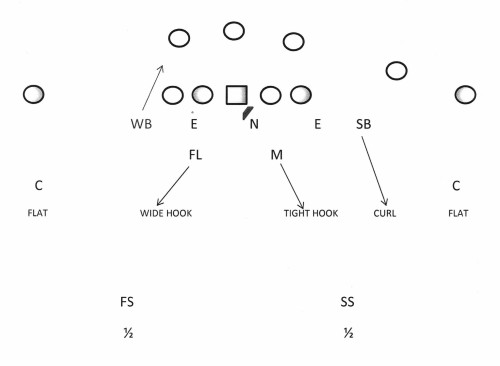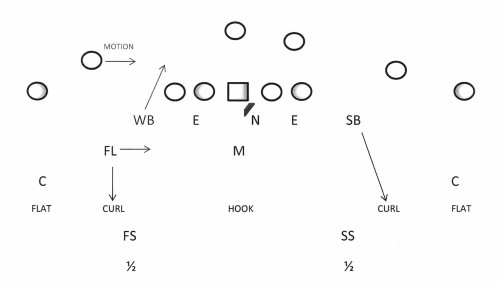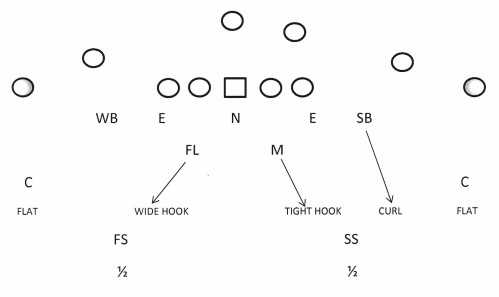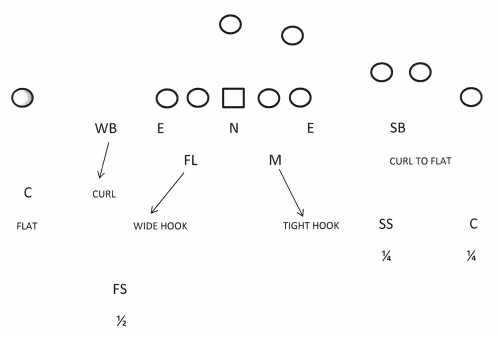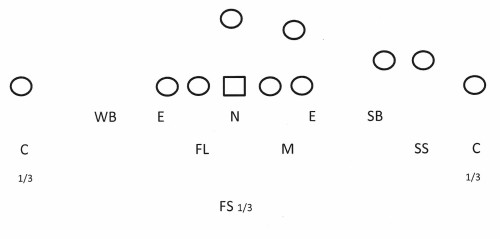Article CategoriesAFM Magazine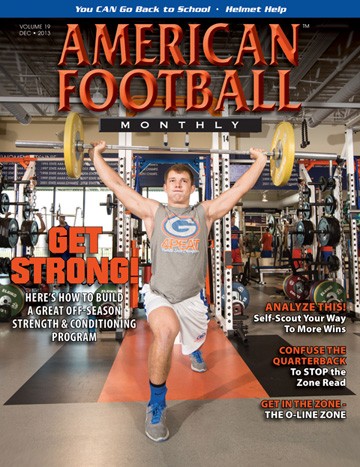
|
Confuse the Quarterback (Part I)by: Rey HernandezRetired High School and College Coach © More from this issue To stop the zone read, it is critical to present a number of different coverages to the opposing quarterback including a two-deep safety look. The zone read spread offense has had a major impact on all levels of football in recent years. Defensive coordinators have had to make adjustments to their base defensive calls in order to defend the basic running plays, play assignment football against the option, and defend the pass. Many years ago at a coaching clinic I heard a coach say that he made it a point to never get into a battle of wits with the opposing coach. This is probably the best advice I ever received from a fellow coach. As a high school defensive coordinator, I accepted the possibility that the offensive coordinator on the other side of the field had his offense well prepared to execute their game plan and that perhaps he was just as smart, if not smarter, than I was. If I was going to get into a thinking match with someone, it wasn’t going to be the opposing offensive coordinator. I chose instead to get into a battle of wits with the teenager who was taking snaps from the center. One of the biggest mistakes coaches make is attempting to cheat the deep safeties up to get them more involved in run support while at the same time maintaining pass integrity at this position. For our defense, the two deep safeties were secondary run support players and they were never asked to assume any primary run support role. The starting depth at the snap of the ball was 14 yards from the line of scrimmage. One of the unorthodox things that we did was play inside leveraged corners and not funnel corners like the vast majority of two-deep teams do. From this position, it is very difficult for wide receivers to stalk block the corners on run plays. We played with nine players in the box. The corners would read the triangle (near lineman, back and quarterback) to get their run-pass read. A pass read by the corner would essentially trigger match-up zone coverage in the flats and the quick-set passing game triggered man-under coverage on slant routes and fade routes at the corner position. The corners always knew that even if they made an incorrect read, the two deep safeties would always be there to pick up any deep threat. The corner must be reminded that the quarterback has a specific amount of time to make a decision and it is imperative that he not make the decision for the quarterback. The quarterback’s selection of a receiver in this vertical stretch scenario becomes much less complicated if the corners begin to settle too soon or if they start coming forward to defend the underneath route. He should force the quarterback to exhaust his read time. When the quarterback sees that the corner is not biting on the short route, he will have to reposition his feet and line of vision in order to dump the ball off to the underneath route. It is not until the corner gets this read that he will come off the intermediate route and move to the underneath receiver. Playing the vertical stretch in this manner will also identify quarterbacks who are greedy and unwilling to settle for the shorter completion. Pressing the intermediate route at the corner position will also allow the safety to get good depth on the hash, create good break angles and defend passes that are now being thrown deeper upfield due to the fact that the quarterback had to hold onto the ball longer than he would have liked to. In order to give your defense an opportunity to execute effectively, you will have to cancel gaps, play assignment football on option and, most importantly, confuse the quarterback by playing multiple coverages including cover 2. We played a 3-4 front for the most part and in our selection of personnel there were three positions in this defensive scheme that whenever possible we would try to fill with players that had a specific physical profile. These positions included the weakside outside linebacker, the “Flip” linebacker and one safety. At the weakside linebacker position, we tried to find a strong athletic player who could come off the edge quickly and had good transitional speed. Against a zone read team, he was a player that a tackle would have a difficult time blocking one-on-one. In slide protection blocking, he would also be able to physically punish a running back assigned to block him when he came off the edge. The Flip linebacker was our weakside inside linebacker. He didn’t have to be any specific size but he had to be smart and quick. Throughout my years coaching, most of our best Flips were around 5’9’’ or shorter. One of our safeties had to be a smart player who could recognize sets and make coverage calls based on the pre-snap strength of the offensive formation and then make coverage checks based on motion. Diagram 1 shows a basic weakside reduction gap control 50 front with cover-2 coverage.
Diagram 1: BASIC WEAKSIDE REDUCTION GAP CONTROL 50 FRONT WITH COVER-2 COVERAGE VERSUS A SET THAT HAS THREE BACKS IN THE BOX
A lineman’s landmark on a zone play is the playside number on the defender’s jersey. It is the landmark where the offensive blocker has to get his back knee. These blockers are being taught to keep their shoulders as square as possible. A tilted nose’s numbers are not visible and keeping your shoulders square becomes a bit more problematic against a nose man who is providing you with half the landmark surface that is needed to adequately execute the tandem blocking scheme. Quite often teams would prefer to attack our weak side where our two best defenders played (the weak linebacker and the Flip) and the defensive end provided them with visible numbers. The strongside defensive end can play in a seven technique but we would often play him in a five technique in order to encourage the offense to attack off the edge. This would direct the point of attack to the edge where we can bounce the run to the strongside linebacker and the inside leveraged corner. The playside safety would fan (fill as needed) on secondary run support. The weakside linebacker comes off the edge hard but usually has the option of coming off his force if he recognizes screen. We called this a green dog. We could, however, take this option away from him when we wanted him to force unencumbered. In such cases we would assign another defender to weak side screen responsibility. IS THE OFFENSIVE COORDINATOR NEEDY OR GREEDY?
Diagram 2 shows this gap control front against a two-back set that employs a quarterback who poses no significant running threat. We would also use this front on selected calls against teams whose quarterback was an effective runner but whose coach desired to protect as a ball carrier. At first glance, the defensive set appears to be quite vulnerable and it certainly can be in certain situations. The reason for incorporating it into the game plan is threefold. First, it gives the quarterback one more thing to think about and it will keep two-deep coverage on his list of things to look out for. Secondly, it will help expose an offensive coordinator who is too pass-happy as well as statistic-minded. The old saying that it is “okay to be needy but not greedy” is applicable in football today now more than ever. A greedy offensive coordinator will sometimes cost his team a game by not taking into consideration his team’s defensive limitations and abandoning all clock management implications. An additional problem might also arise when the receivers who are used to catching a high number of passes are now relegated to mostly a run blocking role. But probably the most important benefit of having this front in your defensive playbook is that if a team cannot run the ball effectively against it, the defense now has a tremendous tactical advantage. One thing that a defensive coordinator should never do is go into a game conceding that his players are unable to effectively play a specific scheme. There were many times in my career where we opened a game in this front and soon discovered that the offense was unable to effectively run the ball with the Flip linebacker out of the box. Once I saw this, I stayed with the call for the rest of the game. Football is a game of match-ups and I always cautioned our players to never look at a comparison score to try to determine what are chances were of beating an upcoming opponent. The greatest gamble in football is substituting hope for facts. Wait until the game starts and then determine how well you match up against your opponent. The strong end will play a five technique and cancel the B-gap. Certain down and distance situations or offensive clock management constraints will at times allow for a seven technique. It is important to remember that we were playing inside leveraged corners and, by not funneling the wide receivers, we were able to eliminate a possible threat to the deep middle seam. Fortunately, the no-chuck five-yard limitation rule allowed our defenders to initiate contact farther upfield. Playing the safeties at 14 yards and getting depth at the snap of the ball also played a significant role in securing this area. This depth made it much easier for safeties to defend this area. It also made it easier for them to defend to the boundary against the vertical passing game. Passing teams used to test the patience of our safeties because it was impossible to employ this scheme in a setting that does not allow for taking receivers off the interstate or breaking up passes on contact. The tradeoff was that in a real game our safeties almost always recorded the most interceptions and broke up many plays running downhill to the reception area.
Diagram 3: BASIC 50 FRONT WITH COVER-2 COVERAGE VERSUS A SET THAT HAS THREE BACKS IN THE BOX Diagram 3 shows a straight 50 front against a zone read spread offense. The straight 50 front package is important for two reasons. It is needed to defend teams that are able to execute their zone read offense effectively against the weak side reduction gap control front. This front will also help you add an element of confusion when it comes to the quarterback’s run reads and pass coverage reads. The base 50 package will allow the defense to include a distinct group of blitz and stunt calls that will complement the weak side reduction package. This package will give the quarterback a number of pass coverages that he will have to identify on a down-to- down basis. The coverage options include cover 2, cover 3, cover 4 (including quarter-quarter-half and quarters across the board) man free and zero coverage.
Diagram 4: BASIC 50 FRONT WITH COVER-2 COVERAGE VERSUS A SET THAT HAS TWO BACKS IN THE BOX Diagram 4 shows a straight 50 front against a set that has two backs in the box. The weakside linebacker is playing over air and is able to walk out and defend the curl zone. Against a trips set, the secondary has the option of checking into quarter-quarter coverage or a strongside invert with a three deep coverage. See Diagrams 5 and 6.
Diagram 5: BASIC 50 FRONT WITH COVER-4 COVERAGE VERSUS A TRIPS SET THAT HAS TWO BACKS IN THE BOX
Diagram 6: BASIC 50 FRONT WITH COVER-3 COVERAGE VERSUS A TRIPS SET THAT HAS TWO BACKS IN THE BOX About the Author: Rey Hernandez recently retired after coaching for 36 years in the San Diego area. He coached at Helix High School for 11 years where he served as the defensive backfield coach. He coached the defensive backs at Grossmont Junior College for two years and spent his last 23 years of coaching at La Jolla high School where he was the defensive coordinator and defensive backs coach. Hernandez was the head coach at La Jolla for the last four seasons. |
|
| HOME |
MAGAZINE |
SUBSCRIBE | ONLINE COLUMNISTS | COACHING VIDEOS |
Copyright 2024, AmericanFootballMonthly.com
All Rights Reserved


